Whether in the digital or power application market, pouch cell pack batteries are becoming a very important technology route.
Pouch cells, in fact, are cells that use aluminum-plastic packaging film as a packaging material. Relatively speaking, the packaging of lithium-ion batteries is divided into two categories, one is soft pack cells and the other is metal cased cells. Metal casing cells include steel and aluminium casing, etc. In recent years, due to the special needs of some cells using plastic casing, can also be classified as such.
The difference between the two, in addition to the different shell materials, determines the packaging method is also different. Soft pack cells are thermally encapsulated, while metal cased cells are generally soldered (laser welding). The reason why soft pack cells can be heat encapsulated is that they use aluminium plastic packaging film as a material.
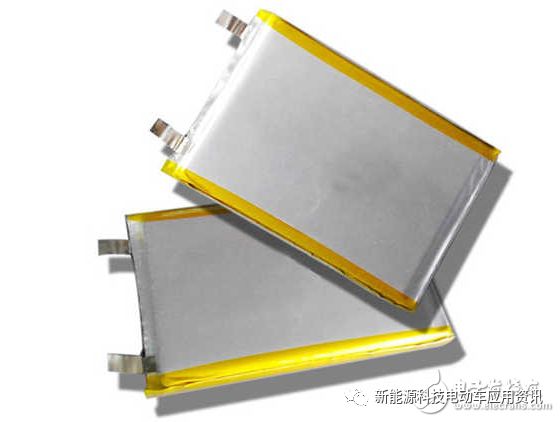
Aluminium packaging film
The aluminium-plastic packaging film (aluminium-plastic film for short) is composed of three layers in cross-section: a nylon layer, an Al layer and a PP layer.
Each layer has its own role to play. Firstly, the nylon layer ensures the shape of the film and that the film does not become deformed before it is manufactured into a lithium-ion battery.
The Al layer is a layer of metallic Al, which prevents water penetration. Lithium-ion batteries are very afraid of water and generally require the water content of the pole piece to be at the PPM level, so the packaging film must be able to block the infiltration of water. Nylon is not waterproof and cannot provide protection. The Al layer also provides the plasticity for punching pits when the aluminium-plastic film is formed, see point 3 for more details.
PP stands for polypropylene, a material whose properties are that it melts at temperatures of over a hundred degrees Celsius and is viscous. So the thermal encapsulation of the battery relies heavily on the PP layer melting and bonding together as the head is heated, then the head is removed and the temperature is lowered and the bond is cured.
The aluminium-plastic film looks simple enough, but in practice it is not so easy to do it, how to combine the three layers of material evenly and firmly. Unfortunately, the best quality aluminium films are now basically imported from Japan, while domestic ones are not unavailable, but the quality still needs to be improved.
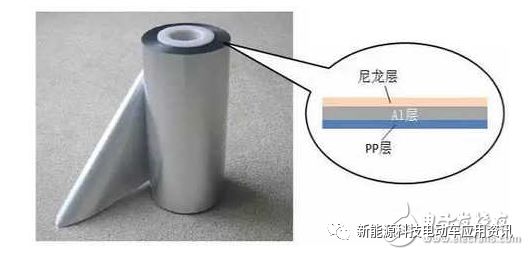
Aluminium film forming process
Soft pack cores can be designed into different sizes according to the customer's needs. Once the shape is designed, a corresponding mould needs to be made to shape the aluminium film. The forming process is also known as "Singijeong" (personally, I think it should be "Singijeong", but that's what everyone says), and as the name implies, the forming mould is heated to create a pit in the aluminium film that can hold the core.
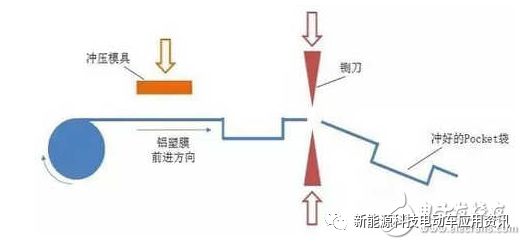
Once the aluminium film has been punched and cut to shape, it is generally known as a Pocket bag, as shown in the diagram below. A single pocket is generally chosen when the core is thin (below left) and a double pocket is chosen when the core is thick (below right), as the deformation on one side can break the deformation limit of the aluminium plastic film and lead to rupture.
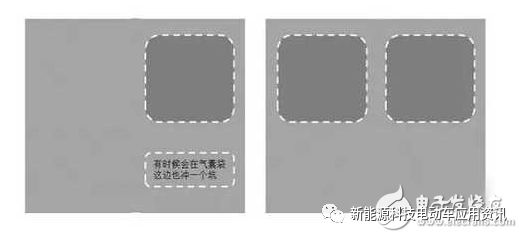
Sometimes, depending on the design, another small pit is punched in the air pocket to enlarge the volume of the air pocket.
Top and side sealing process
Finally we get to the point (how far off-topic are you!) The top and side sealing process is the first encapsulation process for soft pack lithium ion cells. The top and side sealing process actually consists of two processes, top sealing and side sealing. The first step is to place the wound core in the punched pit and then fold the packaging film in half along the dotted line, as shown in the diagram below.

The diagram below shows the locations where the aluminium plastic film will be encapsulated after the core has been loaded, including the top seal area, the side seal area, the first seal area and the second seal area. These are described separately below.
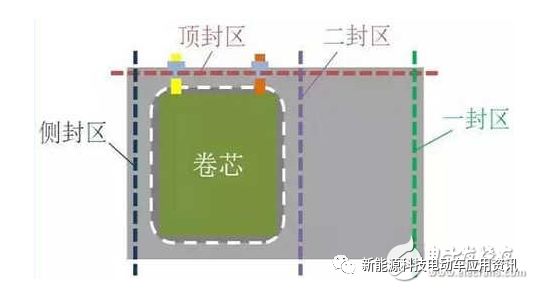
Once the core has been placed in the pit, the entire aluminium film can be placed in the jig for top and side sealing in the top and side sealing machine. The top and side sealer looks like this:
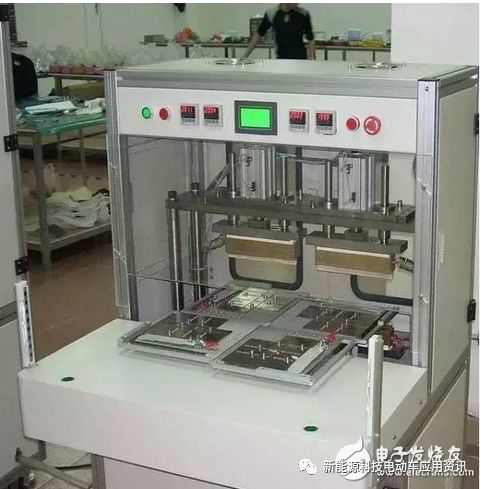
The top and side sealer in this model has four jigs, the one on the left is the top sealer and the one on the right is the side sealer. The two pieces of yellow metal are the top sealing head and there is a bottom sealing head below. When the two sealing heads are encapsulated, they carry a certain temperature (usually around 180°C) and when they are pressed against the aluminium-plastic film, the PP layer of the aluminium-plastic film melts and then sticks together, so that the encapsulation is OK.
There is nothing much to say about the side seal (the side voltage is too far away, so I won't talk about it), but mainly about the top seal, the top seal area is shown in the diagram below. The top seal is to seal the lugs, which are metal (positive aluminium, negative nickel), so how do they fit into the PP package? This is done by a small part of the lug - the lug adhesive. I don't know the exact structure of the lug, so I hope that someone who knows how to do this will add to it. All I know is that it also has a PP cost, which means that it melts and bonds when heated. The encapsulation at the lug level is shown in the circles in the diagram below. During encapsulation, the PP in the lug adhesive melts and bonds to the PP layer of the aluminium-plastic film, creating an effective encapsulation structure.
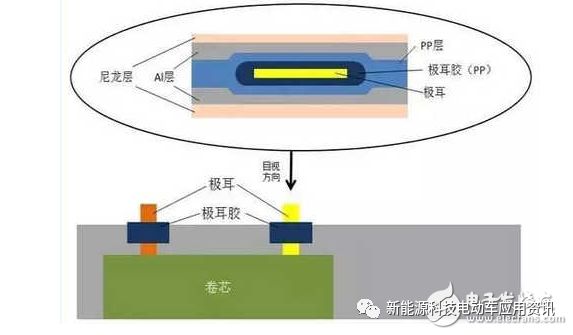
Liquid injection and pre-sealing process
After the top side seal, the soft pack cores are X-rayed to check the parallelism of the rolled cores and then put into the drying room to remove moisture. After a certain amount of time in the drying room, the cores are then filled with liquid and pre-sealed.
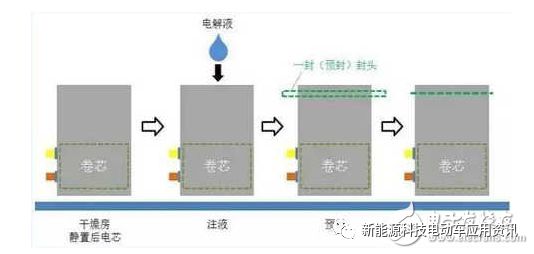
As we know from the introduction above, after the core is sealed on the top side, there is only one opening left in the air pocket, which is used for liquid injection. Immediately after the liquid injection is completed, the pre-sealing of the air pocket side, also known as the first seal, is required. Once the sealing is complete, the core is theoretically completely isolated from the external environment. The encapsulation principle of one seal is the same as that of the top side seal and will not be repeated here.
Resting, forming and jig shaping
After filling and sealing, the cores are first left to rest, depending on the process, at high temperature or at room temperature, in order to allow the electrolyte to fully saturate the electrode. The cores are then ready to be transformed.
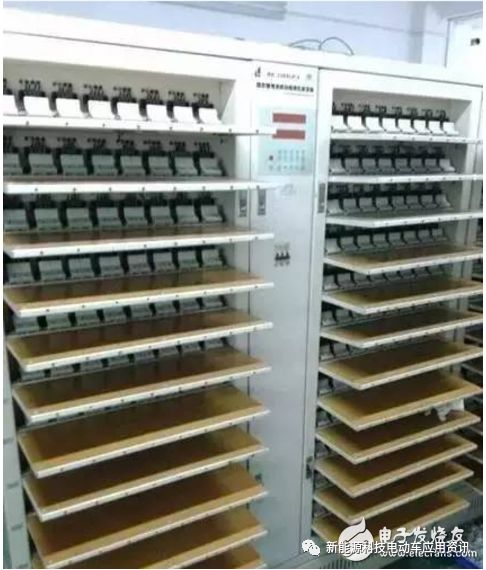
The picture above is the formation cabinet for soft pack cells, in fact it is a charging and discharging device, I searched for a long time but couldn't find a picture with the cells, just think about the picture of the cells clamped on it. The charge is the first charge of the battery, but not to the maximum voltage used, and the charge current is very small.
The aim is to form a stable SEI film on the electrode surface, which is equivalent to a process of "activating" the cell. During this process, a certain amount of gas is generated, which is why an air pocket is set aside for the aluminium plastic film. Some factory processes use jigging, where the cores are clamped in a jig (sometimes a glass plate is used for simplicity and then a steel clamp) and then put into a cabinet to be formed, so that the gas produced is sufficiently squeezed into the gas pocket next to it and the electrode interface is better after formation.
Some cores, especially thick ones, may be deformed after forming due to internal stresses. This is why some factories have a post-forming jig shaping process, also known as jig baking.
Second sealing process
As mentioned earlier, gas is generated during the forming process, so we have to extract the gas before the second encapsulation. Some companies have two processes here: degassing and second sealing, and there is also a second process of cutting the air bag, which I will call second sealing in general here.

In the second seal, the bag is first pierced by a guillotine and vacuumed at the same time, so that the gas and a small part of the electrolyte are extracted from the bag. Then immediately the second seal head is encapsulated in the second seal area to ensure the gas tightness of the core. Finally the packaged cells are cut out of the gas bag and a soft pack cell is basically formed. The second seal is the final encapsulation process for lithium-ion batteries and is based on the same principles as the previous thermal encapsulation.
Subsequent processes
As the subject is asking about encapsulation, the rest of the process has very little to do with encapsulation, so I'll talk about the process after the second seal together.
After cutting the air bag for the second seal, you need to cut and fold the edges, that is, cut one edge and two edges to the right width, and then fold them to ensure that the width of the core does not exceed the standard. After folding, the cores can be put into the dividing cabinet for dividing capacity, which is actually a capacity test to see if the capacity of the cores has reached the minimum value specified. In principle, all cells need to be tested before they leave the factory to ensure that cells with substandard capacity are not sent to customers. However, when there is a large production volume of cells, some companies will do partial capacity splitting to determine the capacity of the batch of cells with statistical probability.
After splitting, the cells with qualified capacity will enter the post-process, including inspection of appearance, yellow glue, side voltage detection, lug transfer welding and so on, which can be increased or decreased according to the customer's needs. Finally, it is OQC inspection and then packaging for shipment.
Note that up to this point it is still just the cores. Downstream of the Pack factory are the various manufacturers, such as Apple, Lenovo and Huawei, who will take the battery pack to the terminal and then to the consumer.






































 401,Building A1,No.168,Changshan IndustrialZone Liulian Community,Pingdi Street,Shenzhen Guangdong Province,China
401,Building A1,No.168,Changshan IndustrialZone Liulian Community,Pingdi Street,Shenzhen Guangdong Province,China